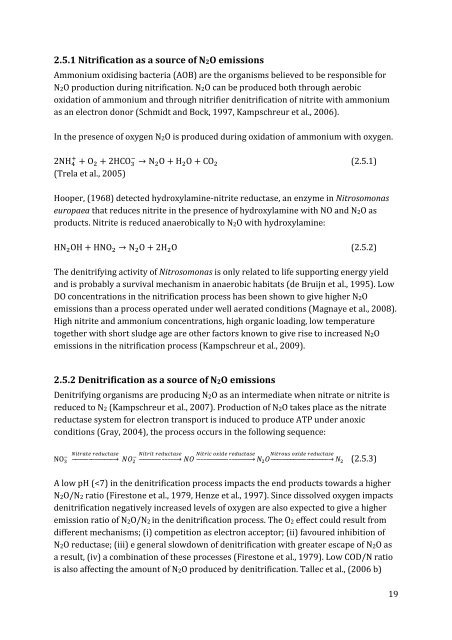N2O production in a single stage nitritation/anammox MBBR process
N2O production in a single stage nitritation/anammox MBBR process
N2O production in a single stage nitritation/anammox MBBR process
You also want an ePaper? Increase the reach of your titles
YUMPU automatically turns print PDFs into web optimized ePapers that Google loves.
2.5.1 Nitrification as a source of <strong>N2O</strong> emissions<br />
Ammonium oxidis<strong>in</strong>g bacteria (AOB) are the organisms believed to be responsible for<br />
<strong>N2O</strong> <strong>production</strong> dur<strong>in</strong>g nitrification. <strong>N2O</strong> can be produced both through aerobic<br />
oxidation of ammonium and through nitrifier denitrification of nitrite with ammonium<br />
as an electron donor (Schmidt and Bock, 1997, Kampschreur et al., 2006).<br />
In the presence of oxygen <strong>N2O</strong> is produced dur<strong>in</strong>g oxidation of ammonium with oxygen.<br />
2NH O 2HCO N O H O CO (2.5.1)<br />
(Trela et al., 2005)<br />
Hooper, (1968) detected hydroxylam<strong>in</strong>e-nitrite reductase, an enzyme <strong>in</strong> Nitrosomonas<br />
europaea that reduces nitrite <strong>in</strong> the presence of hydroxylam<strong>in</strong>e with NO and <strong>N2O</strong> as<br />
products. Nitrite is reduced anaerobically to <strong>N2O</strong> with hydroxylam<strong>in</strong>e:<br />
HN OH HNO N O 2H O (2.5.2)<br />
The denitrify<strong>in</strong>g activity of Nitrosomonas is only related to life support<strong>in</strong>g energy yield<br />
and is probably a survival mechanism <strong>in</strong> anaerobic habitats (de Bruijn et al., 1995). Low<br />
DO concentrations <strong>in</strong> the nitrification <strong>process</strong> has been shown to give higher <strong>N2O</strong><br />
emissions than a <strong>process</strong> operated under well aerated conditions (Magnaye et al., 2008).<br />
High nitrite and ammonium concentrations, high organic load<strong>in</strong>g, low temperature<br />
together with short sludge age are other factors known to give rise to <strong>in</strong>creased <strong>N2O</strong><br />
emissions <strong>in</strong> the nitrification <strong>process</strong> (Kampschreur et al., 2009).<br />
2.5.2 Denitrification as a source of <strong>N2O</strong> emissions<br />
Denitrify<strong>in</strong>g organisms are produc<strong>in</strong>g <strong>N2O</strong> as an <strong>in</strong>termediate when nitrate or nitrite is<br />
reduced to N2 (Kampschreur et al., 2007). Production of <strong>N2O</strong> takes place as the nitrate<br />
reductase system for electron transport is <strong>in</strong>duced to produce ATP under anoxic<br />
conditions (Gray, 2004), the <strong>process</strong> occurs <strong>in</strong> the follow<strong>in</strong>g sequence:<br />
NO <br />
<br />
<br />
<br />
<br />
<br />
<br />
<br />
(2.5.3)<br />
A low pH (















